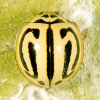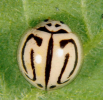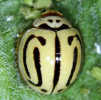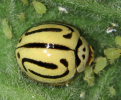 |
Scientific nameAnegleis cardoni (Weise) (=Verania cardoni Weise, Coelophora cardoni
(Weise), Micraspis cardoni (Weise))
Taxonomic positionColeoptera: Coccinellidae: Coccinellinae: Coccinellini
DiagnosisLength 3.50-3.75 mm, width 3.25-3.50 mm. Form round, strongly convex. Ground colour pale
cream to luteous yellow / lemon yellow. Pronotum with a pair of triangular markings on posterior margin and a pair of small, transverse markings in the middle. Scutellum minute, triangular and black. Each elytron with a pair of thin black stripes, outer one anteriorly bent inwards and inner one posteriorly bent
outwards and a small circular spot near apex; sutural line with a black stripe; outer margins of elytra very narrowly black. Ventral side uniform pale yellow. Postcoxal line on abdominal ventrite 1 (Fig. 4) incomplete. Male genitalia (Figs. 6-7) as illustrated. Larva dark brown to pitchy black with creamy white spots.
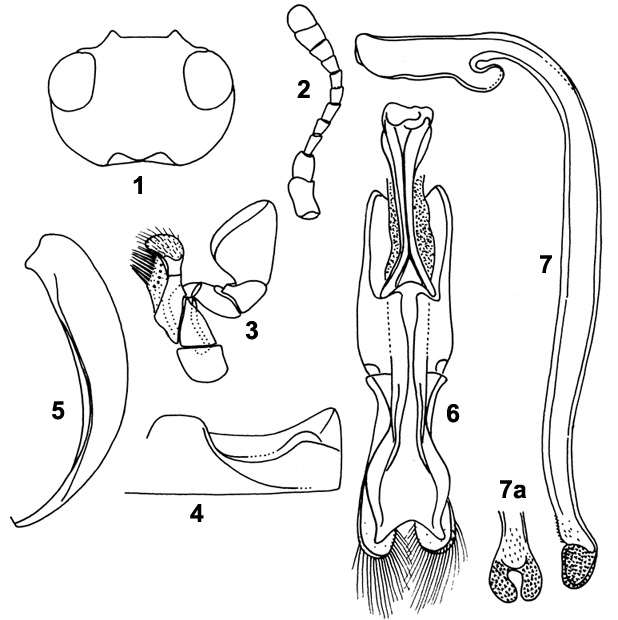 Figs. 1-7. Anegleis cardoni: 1. Head; 2. Antenna; 3. Maxilla; 4. Abdominal ventrite 1 showing postcoxal line; 5. Elytral epipleura; 6-7. Male genitalia: 6. Tegmen, ventral view; 7. Sipho; 7a. Siphonal apex. ImagesDistributionIndia: Widely distributed (Andhra Pradesh; Bihar; Karnataka; Goa; Himachal Pradesh; Orissa;
Punjab; Tamil Nadu; Uttar Pradesh). Sri Lanka. Pakistan.
Prey / Associated habitatPredacious on aphids, mealybugs, scales and whiteflies. HEMIPTERA: Aleyrodidae: Aleurodicus dispersus Russell, Aleurolobus barodensis (Maskell). Aphididae:
Acyrthosiphon pisum (Harris), Aphis craccivora Koch, Aphis gossypii Glover, Brevicoryne brassicae (Linnaeus), Lipaphis pseudobrassicae (Kaltenbach) (as L. erysimi (Kaltenbach)), Macrosiphum euphorbiae (Thomas), Sitobion miscanthi (Takahashi), Toxoptera
aurantii (Boyer de Fonscolombe), and Toxoptera citricida (Kirkaldy). Coccoidea: Coccidohystrix insolita (Green), Lecanium sp., Megapulvinaria maxima (Green),
Monophlebus sp., Orthezia sp., Parasaissetia (as Saissetia) nigra (Nietner), Planococcus citri (Risso), Pseudococcus sp., Pulvinaria psidii Maskell,
Pulvinaria sp., Saissetia coffeae (Walker) (as S. hemisphaerica (Targioni Tozzetti)), green mealy-scale on coffee shade trees. Lophopidae: Pyrilla perpusilla
(Walker). Psyllidae: Diaphorina citri Kuwayama. LEPIDOPTERA: Lycaenidae: Chilades lajus (Stoll). Papilionidae: Papilio demoleus Linnaeus. ARANEAE:
Sparassidae: Olios (as Sparassus) lamarcki (Latreille). Frequently associated with whitefly infestations on Cassia siamea, and guava.
Collected on sandal, Pterolobium indicum, Dodonea viscosa, Canthium didymum, lantana, Zizyphus oenoplia and Ageratum sp. (Chatterjee & Bose, 1933). Associated with aphids, mealybugs and scales infesting cabbage and other crucifers, brinjal, wheat, peas, tomato, Achyranthes aspera, Coccinea indica, Duranta repens, D. erecta, Zizyphus jujuba, chrysanthemum, neem, and several other plants (Afroze, 2000). Collected on sunflower, sunnhemp, sugarcane, and tobacco (label data). Seasonal occurrenceChatterjee & Bose (1933) reported it as passing through many generations in a year (at least six), the populations being high during January-March, and August-December and low during April-July in South India (Chatterjee & Bose, 1933). Collected almost throughout the year, particularly common during June-August in and around Bangalore. Common during mid-September to April in Aligarh, Uttar Pradesh (Afroze, 2000).
Natural enemyNothoserphus mirabilis Brues (Hymenoptera: Proctotrupidae).
References
|
